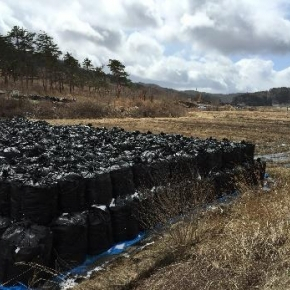Fukushima: lessons learnt from an extraordinary case of soil decontamination
Following the accident at the Fukushima nuclear power plant in Japan, in March 2011, the Japanese authorities decided to carry out major decontamination works in the affected area, which covers more than 9,000 km2. On 12 December 2019, most of this work having been completed, the scientific journal SOIL of the European Geosciences Union (EGU) is publishing a synthesis of some sixty scientific publications that together provide an overview of the decontamination strategies used and their effectiveness, with a focus on radiocesium. This work is the result of an international collaboration led by Olivier Evrard, researcher at the Laboratoire des Sciences du Climat et de l’Environnement [Laboratory of Climate Sciences and the Environment] (LSCE - CEA/CNRS/UVSQ, Université Paris Saclay).
Soil decontamination, which began in 2013 following the accident at the Fukushima Dai-ichi nuclear power plant, has now been completed in the priority areas identified1. Olivier Evrard, researcher at the Laboratory of Climate and Environmental Sciences and coordinator of the study (CEA/CNRS/UVSQ, Université Paris Saclay), in collaboration with Patrick Laceby of Alberta Environment and Parks (Canada) and Atsushi Nakao of Kyoto Prefecture University (Japan), compiled the results of some sixty scientific studies published on the topic.
This synthesis focuses mainly on the fate of radioactive cesium in the environment because this radioisotope was emitted in large quantities during the accident, contaminating an area of more than 9,000 km2. In addition, since one of the cesium isotopes (137Cs) has a half-life of 30 years, it constitutes the highest risk to the local population in the medium and long term, as it can be estimated that in the absence of decontamination it will remain in the environment for about 3 centuries.
"The feedback on decontamination processes following the Fukushima nuclear accident is unprecedented, according to Olivier Evrard, because it is the first time that such a major clean-up effort has been made following a nuclear accident. The Fukushima accident gives us valuable insights into the effectiveness of decontamination techniques, particularly for removing cesium from the environment".
Decontamination activities have mainly targeted agricultural landscapes and residential areas. The review points out that the forests have not been cleaned up - because of the difficulty and very high costs that these operations2 would represent - but they cover 75% of the surface area located within the radioactive fallout zone. These forests constitute a potential long-term reservoir of radiocesium, which can be redistributed across landscapes as a result of soil erosion, landslides and floods, particularly during typhoons that can affect the region between July and October. Atshuhi Nakao, co-author of the publication, stresses the importance of continuing to monitor the transfer of radioactive contamination at the scale of coastal watersheds that drain the most contaminated part of the radioactive fallout zone. This monitoring will help scientists understand the fate of residual radiocesium in the environment in order to detect possible recontamination of the remediated areas due to flooding or intense erosion events in the forests.
This synthesis indicates that removing the surface layer of the soil to a thickness of 5 cm, the main method used by the Japanese authorities to clean up cultivated land, has reduced cesium concentrations by about 80% in treated areas. Nevertheless, the removal of the topsoil, is relatively expensive, since these operations costthe Japanese government around €24 billion. In addition, this technique generates a significant amount of waste, which is difficult to treat and expensive to transport and store for several decades in the vicinity of the power plant a step that is necessary before it is shipped to final disposal sites located outside Fukushima prefecture by 2050. Fukushima's decontamination efforts had generated about 20 million cubic metres of waste by early 2019.
Source
“Effectiveness of landscape decontamination following the Fukushima nuclear accident: A review”,
Olivier Evrard, J. Patrick Laceby, and Atsushi Nakao,
EGU open access journal SOIL, 12 décembre 2019, doi: https://doi.org/10.5194/soil-5-333-2019
